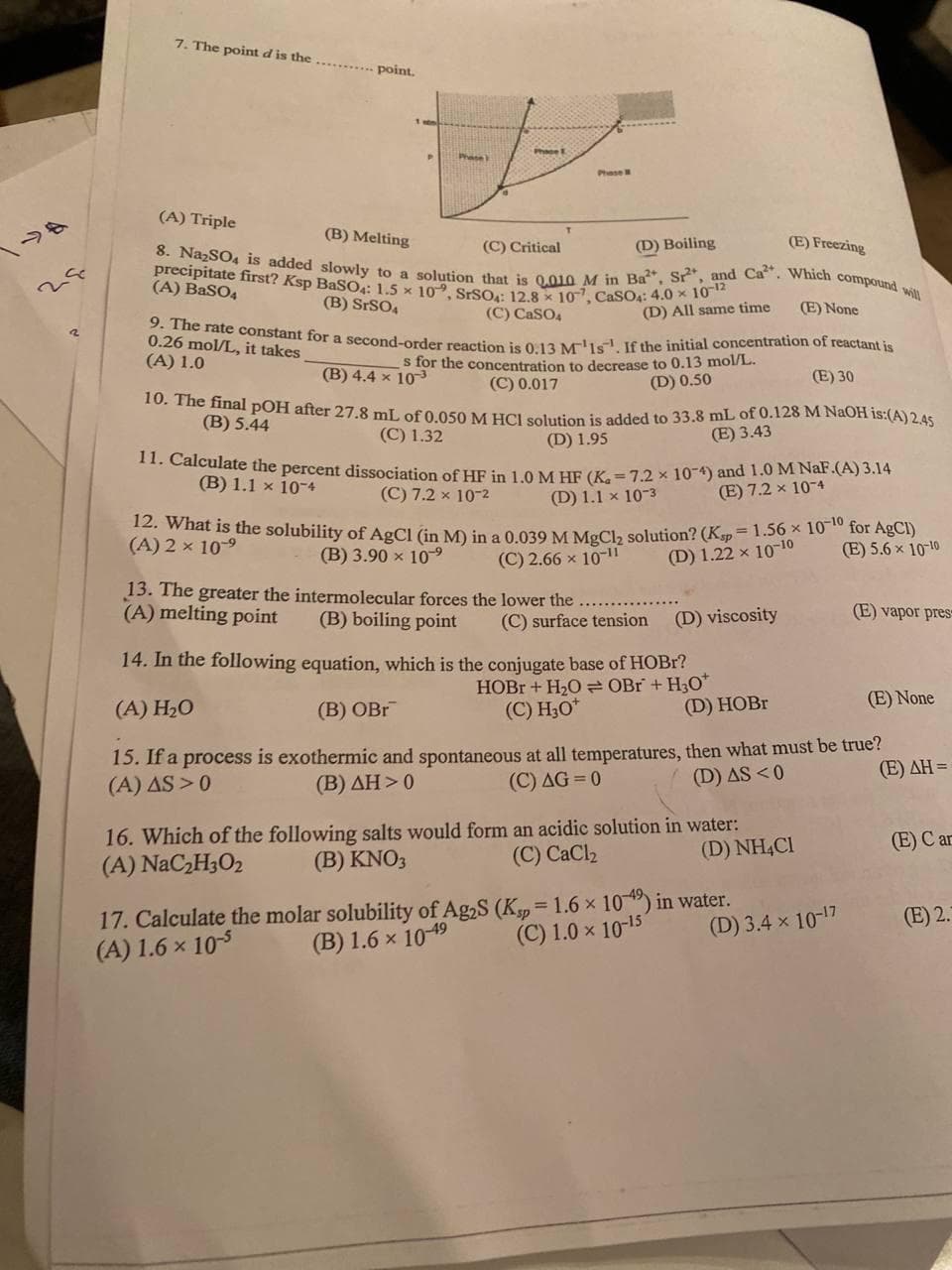Chapter4: Calculations Used In Analytical Chemistry
Section: Chapter Questions
Problem 4.23QAP
Related questions
Question
Please solve this

Transcribed Image Text:2
7. The point d is the
point.
Phase
(A) Triple
(B) Melting
(C) Critical
(D) Boiling
(E) Freezing
8. Na₂SO4 is added slowly to a solution that is 0,010 M in Ba, Sr, and Ca. Which compound will
precipitate first? Ksp BaSO4: 1.5 x 10", SrSO4: 12.8 x 107, CaSO4: 4.0 x 10-12
(A) BaSO4
(B) SrSO4
(C) CaSO4
(D) All same time
(E) None
9. The rate constant for a second-order reaction is 0.13 M¹1s. If the initial concentration of reactant is
0.26 mol/L, it takes
(A) 1.0
(B) 4.4 x 103
s for the concentration to decrease to 0.13 mol/L.
(C) 0.017
(D) 0.50
(E) 30
10. The final pOH after 27.8 mL of 0.050 M HCl solution is added to 33.8 mL of 0.128 M NaOH is:(A) 2.45
(B) 5.44
(C) 1.32
(D) 1.95
(E) 3.43
11. Calculate the percent dissociation of HF in 1.0 M HF (K₂= 7.2 x 10-4) and 1.0 M NaF.(A) 3.14
(B) 1.1 x 10-4
(C) 7.2 x 10-²
(D) 1.1 x 10-3
(E) 7.2 x 10-4
12. What is the solubility of AgCl (in M) in a 0.039 M MgCl₂ solution? (Ksp = 1.56 x 10-10 for AgCl)
(A) 2 × 10⁹
(B) 3.90 × 109⁹
(E) 5.6 × 10-10
(C) 2.66 x 10-11
(D) 1.22 x 10-10
13. The greater the intermolecular forces the lower the.
(A) melting point
(B) boiling point
(D) viscosity
(E) vapor pres
(C) surface tension
14. In the following equation, which is the conjugate base of HOBr?
HOBr + H₂O OBr + H30*
(C) H₂O*
(A) H₂O
(E) None
(B) OBr
(D) HOBr
15. If a process is exothermic and spontaneous at all temperatures, then what must be true?
(A) AS >0
(B) AH>0
(C) AG=0
(Ε) ΔΗ =
(D) AS <0
16. Which of the following salts would form an acidic solution in water:
(A) NaC₂H30₂
(E) Car
(B) KNO3
(D) NH4Cl
(C) CaCl₂
17. Calculate the molar solubility of Ag2S (Ksp = 1.6 × 10-49) in water.
(A) 1.6 × 10-5
(B) 1.6 x 10-49
(E) 2.
(C) 1.0 x 10-15
(D) 3.4 × 10-¹7
Phase
Phase
Expert Solution
This question has been solved!
Explore an expertly crafted, step-by-step solution for a thorough understanding of key concepts.
Step by step
Solved in 2 steps

Knowledge Booster
Learn more about
Need a deep-dive on the concept behind this application? Look no further. Learn more about this topic, chemistry and related others by exploring similar questions and additional content below.Recommended textbooks for you


Chemistry & Chemical Reactivity
Chemistry
ISBN:
9781133949640
Author:
John C. Kotz, Paul M. Treichel, John Townsend, David Treichel
Publisher:
Cengage Learning

Chemistry & Chemical Reactivity
Chemistry
ISBN:
9781337399074
Author:
John C. Kotz, Paul M. Treichel, John Townsend, David Treichel
Publisher:
Cengage Learning


Chemistry & Chemical Reactivity
Chemistry
ISBN:
9781133949640
Author:
John C. Kotz, Paul M. Treichel, John Townsend, David Treichel
Publisher:
Cengage Learning

Chemistry & Chemical Reactivity
Chemistry
ISBN:
9781337399074
Author:
John C. Kotz, Paul M. Treichel, John Townsend, David Treichel
Publisher:
Cengage Learning

Chemistry
Chemistry
ISBN:
9781305957404
Author:
Steven S. Zumdahl, Susan A. Zumdahl, Donald J. DeCoste
Publisher:
Cengage Learning

Chemistry: An Atoms First Approach
Chemistry
ISBN:
9781305079243
Author:
Steven S. Zumdahl, Susan A. Zumdahl
Publisher:
Cengage Learning
